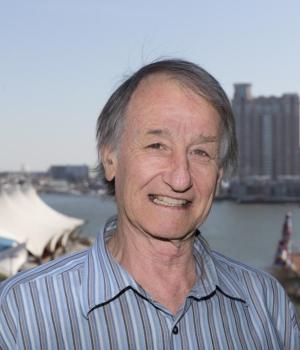
Frank Robb
Research Interests
- Mechanisms of heat tolerance in hypothermophiles
- Heat shock proteins, including their use to improve high-temperature industrial or biomedical processes
Robb's main research interest is in hyperthermophiles that can survive and even thrive at temperatures up to 100°C (212°F), which in mere seconds can destroy DNA, "normal" proteins, and, hence, life. Dr. Frank Robb's main interest is learning specifically how these organisms can maintain stable proteins in the face of a thermal onslaught. His key focus is on heat shock proteins, known as chaperones, that the organisms produce to allow them to fold the proteins necessary for life. Robb and his colleagues are working toward various applications including using chaperones to improve high-temperature industrial or biomedical processes. The team, supported by the Bill and Melinda Gates Foundation, is exploring methods that seek to enhance the durability and immunogenicity of live vaccines through expression of heat shock proteins from thermophiles. If successful, the project will enable enhanced long term storage of vaccines in locations lacking refrigeration, for example in developing nations.
Another area of research is in tapping the thermophiles' penchant for producing hydrogen as a byproduct in order to develop new hydrogen production methods to add to the arsenal of technology needed for future supplies of renewable energy. Recent work has also focused on extremely stable cellulases for exploiting woody feedstocks for biofuel production.
The search for thermophiles has taken Robb to some exotic locales, including deep-sea hydrothermal vents, geothermal springs in the volcanic regions of New Zealand, Iceland, Eastern Russia's Kamchatka, as well as Yellowstone and Lassen National Parks.
Selected Publications
- Antranikian G, Suleiman M, Schäfers C, Adams MWW, Bartolucci S, Blamey JM, Birkeland NK, Bonch-Osmolovskaya E, da Costa MS, Cowan D, Danson M, Forterre P, Kelly R, Ishino Y, Littlechild J, Moracci M, Noll K, Oshima T, Robb FT, Rossi M, Santos H, Schönheit P, Sterner R, Thauer R, Thomm M, Wiegel J, Stetter KO (2017) Diversity of bacteria and archaea from two shallow marine hydrothermal vents from Vulcano Island.) Extremophiles. 21(4):733-742. doi: 10.1007/s00792-017-0938-y
- Spigolon, D, D. T Gallagher, A Velazquez-Campoy, D Bulone, J Narang, P L San Biagio, F Cappello, A J.L. Macario, E Conway de Macario, FT Robb. (2017). Quantitative analysis of the impact of a human pathogenic mutation on the CCT5 chaperonin subunit using a proxy archaeal ortholog. Biochemistry and Biophysics Reports 12:66-71 . DOI: 10.1016/j.bbrep.2017.07.011
- Conway de Macario E, Robb FT, Macario AJ. (2017) Prokaryotic Chaperonins as Experimental Models for Elucidating Structure-Function Abnormalities of Human Pathogenic Mutant Counterparts. Front Mol Biosci. 9;3:84. doi: 10.3389/fmolb.2016.00084.
- An, Y J*, Rowland, SE*, Na, JH*, Spigolon, D, Hong S K, Yoon Y J, Lee, JH, Cha, S S, FT Robb (2017). Structural and mechanistic characterization of a novel archaeal-like chaperonin from a thermophilic bacterium. Nature Communications, In Press. *Authors contributed equally
- Rowland, SE and Robb FT (2017) "Structure, Function and Evolution of the Hsp60 Chaperonins" in Heat Shock Proteins, Vol. 11, Santosh C. M. Kumar and Shekhar C. Mande (Eds): Prokaryotic Chaperonins, 978-981-10-4650-6. Springer. http://www.springer.com/us/book/9789811046506.
- Vetriani, C and FT Robb (2017). Scientia online article on University of Maryland/Rutgers University collaboration: http://www.scientia.global/professor-costantino-vetriani-professor-frank-t-robb-uncovering-relationship-aquatic-thermophiles-human-bacterial-pathogens/
